SABBATH EVE
The Sabbath laws originate in the Ten Commandments. Two slightly different versions occur in the Bible. In the book of Exodus we read  (Zachor) Remember the Sabbath day and keep it holy. And the reason given is For in six days the Lord made heaven and earth and sea and all that is in them, and He rested on the seventh day, therefore the Lord blessed the seventh day; therefore the Lord blessed the Sabbath day and hallowed it. 1.
(Zachor) Remember the Sabbath day and keep it holy. And the reason given is For in six days the Lord made heaven and earth and sea and all that is in them, and He rested on the seventh day, therefore the Lord blessed the seventh day; therefore the Lord blessed the Sabbath day and hallowed it. 1.
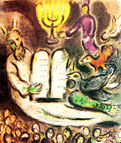
|
Moses with the Ten
Commandments.
Marc Chagall. |
In Deuteronomy we read  (Shamor) Observe the Sabbath day and keep it holy as the Lord your God has commanded you.It continues in the same way as the Exodus version Six days shall you labour and do all your work, but the seventh day is a Sabbath to the Lord your God; you shall not do any work - you, your son or your daughter, your male or female servant, your ox or your ass, or any of your cattle, or the stranger in your settlements, so that your male and female servant may rest as well as you do. 2. In Deuteronomy it continues Remember that you were a slave in the land of Egypt and the Lord freed you from there with a mighty hand and an outstretched arm; therefore the Lord your God has commanded you to observe the Sabbath day.
(Shamor) Observe the Sabbath day and keep it holy as the Lord your God has commanded you.It continues in the same way as the Exodus version Six days shall you labour and do all your work, but the seventh day is a Sabbath to the Lord your God; you shall not do any work - you, your son or your daughter, your male or female servant, your ox or your ass, or any of your cattle, or the stranger in your settlements, so that your male and female servant may rest as well as you do. 2. In Deuteronomy it continues Remember that you were a slave in the land of Egypt and the Lord freed you from there with a mighty hand and an outstretched arm; therefore the Lord your God has commanded you to observe the Sabbath day.
The explanation of Deuteronomy seems to describe the beginning of the 6-day working week, and fits in well to the historic context. The Ten Commandments date back to the Exodus. The escaping Israelites had experienced slavery when they had to work hard seven days a week without let up, so they clearly recognised the importance of having one day which they could use for prayer, contemplation and the study of matters which were of a spiritual and more lasting value.
(1) Exodus 20, 8ff. (2) Deuteronomy 5, 12 ff.
When does the Sabbath start? The Rabbis of old defined the time by referring to two Biblical texts:
It shall be to you a Sabbath of rest, and you shall afflict your souls; in the ninth day of the month at evening, from evening to evening, shall you celebrate your Sabbath, 3.
And there was evening and there was morning, the second day. Note it does not say "it was morning and there was evening", which shows that days began in the evening. 4.
Amongst the more Orthodox Jews the practice is to stop work at least 30 minutes before this, so as not to run the risk of doing work on the Sabbath. This is a result of the teaching of putting a fence round the Torah.5. Others light the Sabbath candles eighteen minutes before sunset. 6.
This follows early Rabbinic teachings: Rabbi Jose also said: May my lot be of those who welcome the Sabbath in Tiberias and who let it depart in Sepphoris. 7. (The sun sets early in Tiberias and late at Sepphoris because of the difference in the altitude.)
(3) Leviticus 23, 32. (4) Gen 1. 8. (5) Avot 1, 1. (6) Art Scroll Siddur, p. 296. Etc. (7) Shabbat 118b.
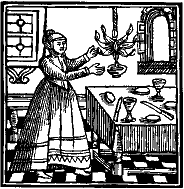
|
Lighting The Sabbath Lamp.
Amsterdam, 1695. |
It is the custom to light at least two candles just before the Sabbath on a Friday night. Some thought it praiseworthy to light many candles.8. The two candles were taken to symbolise the two words of command in the two versions of the Ten Commandments  (Shamor) Observe and
(Shamor) Observe and  (Zachor) Remember (see SABBATH). Another explanation is that the old dwellings had two rooms and one light was for each room. The illustration from 1695, lighting the special Sabbath oil lamp.
(Zachor) Remember (see SABBATH). Another explanation is that the old dwellings had two rooms and one light was for each room. The illustration from 1695, lighting the special Sabbath oil lamp.
Initially the candle lighting was the last act before the Sabbath but this has gradually changed into the first act of the Sabbath. Both the Mishnah and Talmud say that kindling Sabbath lights was a duty that was praiseworthy. Rabbi Huna said: He who habitually practises [the lighting of] the (Sabbath) lamp will possess scholarly sons. 9.
Light is symbolic of God's presence and of His teachings and has a parallel use in the  (Ner Tamid) the perpetual light, which hangs before the Ark in the Synagogue, where God's teachings on Torah scrolls are kept. This interpretation follows the verse The commandment is a lamp, and the Torah is light. 10.
(Ner Tamid) the perpetual light, which hangs before the Ark in the Synagogue, where God's teachings on Torah scrolls are kept. This interpretation follows the verse The commandment is a lamp, and the Torah is light. 10.
(8) Ganzfried tr. Goldin Code of Jewish Law. Vol 2, chap 75, #2. (9) Talmud, Shabbat 23a. (10) Proverbs 6, 23.
Although the blessing over the candles speaks God having sanctified us with his commandments and commanded us to kindle the Sabbath lights, strictly speaking the lighting of candles is not one of the 613 mitsvot mentioned in the Torah. The custom is first mentioned in the Mishnah c. 210 CE where it is taken for granted as an established practice, which needed no explanation. At that time oil lamps were used. The Talmud mentions the lighting of lamps, but does not mention the blessing over the lights. It was not until the 12th Century that the Geonim instructed people to say the blessing. This was to show that it was both permissible to have lights on the Sabbath provided they had been lit before the day began, and it was intended to correct the gloomy view of the Karaites who did not permit any lights or fires on the Sabbath.11. As the candle lighting symbolises the start of the Sabbath, and the observance of the Sabbath is the start of fulfilling a mitsvah, it is not out of place to say a blessing.
(11) EJ vol 15, p. 735. Schauss: The Jewish Festivals, p. 291, note 30.
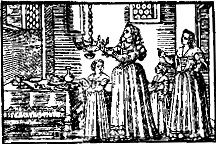
|
Lighting The Sabbath Lamp.
Venice, 1601. |
The candle lighting was regarded as the task of the mother of the family as she was usually the one at home.12. This is not always the situation today. Even in previous times, men who were travelling away from home or male students who lived alone were required to light candles and say the blessing.13. Today, we recognise the male chauvinism of the old interpretation that said that it is the task of women to light candles to make amends for the fact that Eve, the first woman brought the darkness of sin into the world. 14.
(12) Shulchan Aruch, Orach Chayim 263, 3. (13) Solomon Freehof: Modern Reform Responsa, p. 92 where original sources are given. (14) Ganzfried: Code of Jewish Law, vol 2, chap 75, #5.
The normal custom is to say a blessing before performing a mitzvah so that one performs the mitzvah with the right intention, and then one makes use of that over which you have said the blessing. Eg. The blessings over bread or wine. However once you say the blessing over the candles which mentions the Sabbath, the Sabbath is considered to have begun, and then you are not permitted to kindle a fire to light them. The solution put forward in the 16th century was to light the candles, but not make use of the light until the blessing is said, and so the eyes are covered to prevent one doing so. 15.
(15) Shulchan Aruch, Orach Chayim, 263, Code of Jewish Law vol 2, chap 75, #4.
After opening their eyes, some people wave their arms in a kind of circular motion usually towards themselves and usually three times. Various explanations have been suggested. One is that one is symbolically making use of the light because having said a blessing over the candles one should derive benefit of the light and warmth from them. Other explanations are that we are welcoming the Sabbath into our home or beckoning to the Sabbath as a bride to come into our home.
(see alsoLECHA DODI.)
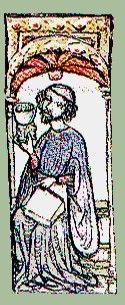
|
Making Kiddush.
Darmstadt, 15th CE. |
 (Kiddush), Sanctification, this is the name of the prayer, which declares that a holy day (Sabbath or Festival) has begun. Kiddush was seen as the fulfilling of the Biblical command to remember the Sabbath day to keep it holy 16. and was required to be said over a cup of wine.17. (See WINE). Before one starts the Friday evening meal one is required to say the Kiddush and the grace before meals.18.
(Kiddush), Sanctification, this is the name of the prayer, which declares that a holy day (Sabbath or Festival) has begun. Kiddush was seen as the fulfilling of the Biblical command to remember the Sabbath day to keep it holy 16. and was required to be said over a cup of wine.17. (See WINE). Before one starts the Friday evening meal one is required to say the Kiddush and the grace before meals.18.
All observances should be carried out with Kavanah (the right intention). Accordingly, the Kiddush mentions the two reasons for observing the Sabbath mentioned in the two versions of the Ten commandments. These are remembrance of the redemption from Egyptian slavery and also of the Genesis legend of the six days of creation of the world.
In Talmudic times it was the custom to say the Kiddush both in the home and at the Friday evening service in the Synagogue. Regarding the home, Rav said In order to acquit his children and his household of their duty. Regarding the Synagogue, Samuel said: In order to acquit travellers of their obligation, for they eat, drink, and sleep in the synagogue.19.
A shorter form of the Kiddush is said before the mid day meal on Saturdays.
(See also WINE,
ORDER OF KIDDUSH BLESSINGS,
TWO CHALLOT)
(16) Exodus 20, 8. (17) Pesachim 106a. (18) Pesachim 105a. (19) Pesachim 101a.
Wine is a symbol of joy, and is drunk on all happy occasions like Sabbaths, festivals weddings, etc. as the psalmist wrote Wine that gladdens the heart of man. 20. The custom of drinking wine on Sabbath eve is mentioned in the Mishnah where it is discussed by the schools of Hillel and Shammai. This would place the discussion as either 1st century BCE or 1st century CE. Although the custom to drink wine was established then, the liturgy was not yet fixed. (See next item)
(20) Psalm 104, 15.
Beth Hillel maintain: He recites a blessing over the wine and then recites a blessing for the day, because the wine enables the Kiddush to be recited. Another reason: the blessing for wine is constant, while the blessing for the day is not constant.21. (The blessing said over wine is the same whenever one drinks wine. The blessing for the day varies whether it is a Sabbath or Festival) and the rule is that between that which is constant and that which is not constant, that which is constant comes first. 22.
(21) Tamud Pesachim 114a. (22) Ibid.
Originally, a portion of the dough being baked was made into a cake or loaf called  (Challah) and offered up in the Temple. As the Bible states:Then it shall be, that, when you eat of the bread of the land, you shall offer up an offering to the Lord. You shall offer up a cake (challah) of the first of your dough for an offering; as you do the offering of the threshing floor, so shall you present it. From the first of your dough you shall give to the Lord an offering in your generations. 23.
(Challah) and offered up in the Temple. As the Bible states:Then it shall be, that, when you eat of the bread of the land, you shall offer up an offering to the Lord. You shall offer up a cake (challah) of the first of your dough for an offering; as you do the offering of the threshing floor, so shall you present it. From the first of your dough you shall give to the Lord an offering in your generations. 23.
After the Temple was destroyed in 70 CE it was no longer possible to make such an offering, so Jewish housewives used to burn the same portion or Challah in the fire and bake with the rest.
She takes it (the dough) on the point of the shovel and throws it in the oven, and then separates other challah in order that the law of challah may not be forgotten and an adult priest eats it. 24
The final development was that the name challah transferred from the burnt dough to the bread which was baked from the remaining dough.
(23) Numbers 15, 19-21. (24) Bechorot 27a.
Challah is made from white bread because the white or more refined flour was regarded as being of a higher quality. And one should eat the best of foods to honour the Sabbath  (Lichvod Ha-Shabbat). Other ways of honouring the Sabbath are using a white table cloth, wearing ones best clothes and drinking wine for Kiddush. A minimum of three meals should be eaten during the Sabbath for the same reason.
(Lichvod Ha-Shabbat). Other ways of honouring the Sabbath are using a white table cloth, wearing ones best clothes and drinking wine for Kiddush. A minimum of three meals should be eaten during the Sabbath for the same reason.
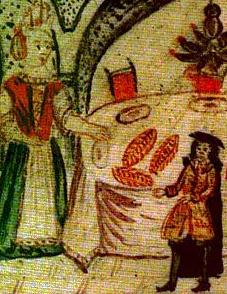
|
Sabbath Eve,
Germany c. 1720. CE. |
Many Jews have two loaves each Friday. This custom has been linked to the story of the manna in the wilderness when no manna was provided on the Shabbat but they collected a double sized portion on the Friday morning. See, because the Lord has given you the Sabbath, therefore he gives you on the sixth day the bread of two days.25. Others see the two loaves as a reminder of the two loaves of show bread which were used in the Temple.26. Today with smaller sized families and with the traditional concern not to waste food, many have two small challot or just one challah. As the Sabbath challah is usually plaited with several pieces of dough, it is possible to think of this as more than one loaf intertwined. (The illustration is puzzling. It is only a part of a larger picture. There are four Challot in the full picture; but there is no challah cloth.)
(25) Exodus 16, 29. (26) Exodus 25, 30 and Leviticus 24, 5 - 8. The latter says that the show bread was set out on the Sabbath, but speaks of twelve loaves.
While the blessings over the wine are said it usual to have the challah covered over with a cloth. As the challah has been compared with the manna so the cloth has been picturesquely compared with dew in the verse: And when the dew that lay was gone, behold, upon the face of the wilderness there lay a small round thing, as small as hoarfrost on the ground. 27. However the custom is more probably due to the need to focus the attention first on the wine and then on the bread as we say the blessings over them. This is very similar to the way that the pieces of matsah are covered and uncovered at the Seder. 28.
(27) Exodus 16, 14 (28) Pesachim 100b.
In many families it is the custom to have salt on their challah. This is probably based on the verse: And every sacrifice of your meal offering shall you season with salt. 29.
(See alsoCHALLAH, THE NAME.)
(29) Leviticus 2, 13.
The parents normally bless their children either by saying the blessing said by Jacob over Joseph's children: May, God make you as Ephraim and as Manasseh. 30. over the boys and a similar blessing for girls. Or by saying the priestly blessing 31. over all the children together.
(30) Genesis 48, 20. (31) Numbers 6, 24 - 26.
In some homes it is the custom for the father to read the alphabetically arranged passage from Proverbs in praise of his wife:
A worthy woman who can find? For her price is far above rubies�her husband also, and he praises her: ' Many daughters have done virtuously, but you excel them all'. 31.
(32) Proverbs 31, 10 - 31.
This is a hymn sung during the Friday night service and was composed in mid 16th by Solomon Alkabets. The hymn is largely composed of phrases of Biblical verses cleverly woven together to form a poem. The initial Hebrew letters of the verses spell out the authors name Sh'lomo ha'Levi, Solomon the Levite. The theme expressed in the chorus and last verse is that the Sabbath should be welcomed as a bride. In the Talmud we read Hanina used to say: �Come, let us go forth to meet the bride, the queen!� 32. This idea has inspired other poets and is based on the idea that the Jewish people are wedded to the Sabbath and the Sabbath brings joy and happiness, warmth and love into our homes and our lives. Because of the reference to the bride, in many congregations it is the custom to stand up and face the door, as if a bride were entering the Synagogue on her way to the Chuppah (Wedding canopy). In Safed in the 16th century the Rabbi Isaac Luria actually used to lead his congregation of Kabbalists through the streets as if escorting the bride, as was then the custom at weddings.
(32) Baba Kama 32 a/b.
A number of table songs were written and composed for the Sabbath. These date back at least to the 16th century to the time of Isaac Luria. These songs were sung at home on Sabbaths and Festivals and although religious in thought were often of a light-hearted nature. They added both to the joy and spirituality of the day and by all the members joining in the singing them together they strengthened the family ties in communal worship. Some of these songs have been incorporated into Sabbath Eve services in Reform and Liberal synagogues.
This song asking for the blessing of Sabbath peace refers to an old legend which speaks of two angels that accompany a man home from Synagogue on a Friday night. One is good and the other bad. If when they come in sight of the home, it is all prepared for the Sabbath with the candles lit, then the good angel says "May the next Sabbath be like this one," and the bad angel has to say "Amen." But if the house is dark and unprepared, then the bad angel says "May the next Sabbath be like this one" and the good angel has reluctantly to say "Amen." This Talmudic story 33. dates from a time when only the men went to Synagogue on a Friday night and the women stayed at home.
(33) Shabbat 119b. story attributed Rabbi Jose.
This song emphasizes the fact that the Sabbath was not to be a gloomy observance of negative commandments forbidding this or that activity, but rather the happy experience of Sabbath peace, family love and with a certain amount of prayer study and reading. The author's name was Isaac appears in an acrostic and has been dated to either the 13th or 16th century. 34.
(34) I. Abrahams: Notes on the Singers Prayer Book p. cclx.
When meeting someone on the Sabbath it is usual to greet them with  (Shabbat Shalom) meaning Sabbath Peace or Sabbath Greetings. Ashkenazim tend to use Yiddish and say Gud Shobbos which means have a good Sabbath.
(Shabbat Shalom) meaning Sabbath Peace or Sabbath Greetings. Ashkenazim tend to use Yiddish and say Gud Shobbos which means have a good Sabbath.
 (Zachor) Remember the Sabbath day and keep it holy. And the reason given is For in six days the Lord made heaven and earth and sea and all that is in them, and He rested on the seventh day, therefore the Lord blessed the seventh day; therefore the Lord blessed the Sabbath day and hallowed it. 1.
(Zachor) Remember the Sabbath day and keep it holy. And the reason given is For in six days the Lord made heaven and earth and sea and all that is in them, and He rested on the seventh day, therefore the Lord blessed the seventh day; therefore the Lord blessed the Sabbath day and hallowed it. 1. 
 (Shamor) Observe the Sabbath day and keep it holy as the Lord your God has commanded you.It continues in the same way as the Exodus version Six days shall you labour and do all your work, but the seventh day is a Sabbath to the Lord your God; you shall not do any work - you, your son or your daughter, your male or female servant, your ox or your ass, or any of your cattle, or the stranger in your settlements, so that your male and female servant may rest as well as you do. 2. In Deuteronomy it continues Remember that you were a slave in the land of Egypt and the Lord freed you from there with a mighty hand and an outstretched arm; therefore the Lord your God has commanded you to observe the Sabbath day.
(Shamor) Observe the Sabbath day and keep it holy as the Lord your God has commanded you.It continues in the same way as the Exodus version Six days shall you labour and do all your work, but the seventh day is a Sabbath to the Lord your God; you shall not do any work - you, your son or your daughter, your male or female servant, your ox or your ass, or any of your cattle, or the stranger in your settlements, so that your male and female servant may rest as well as you do. 2. In Deuteronomy it continues Remember that you were a slave in the land of Egypt and the Lord freed you from there with a mighty hand and an outstretched arm; therefore the Lord your God has commanded you to observe the Sabbath day.
 (Ner Tamid) the perpetual light, which hangs before the Ark in the Synagogue, where God's teachings on Torah scrolls are kept. This interpretation follows the verse The commandment is a lamp, and the Torah is light. 10.
(Ner Tamid) the perpetual light, which hangs before the Ark in the Synagogue, where God's teachings on Torah scrolls are kept. This interpretation follows the verse The commandment is a lamp, and the Torah is light. 10.

 (Kiddush), Sanctification, this is the name of the prayer, which declares that a holy day (Sabbath or Festival) has begun. Kiddush was seen as the fulfilling of the Biblical command to remember the Sabbath day to keep it holy 16. and was required to be said over a cup of wine.17. (See
(Kiddush), Sanctification, this is the name of the prayer, which declares that a holy day (Sabbath or Festival) has begun. Kiddush was seen as the fulfilling of the Biblical command to remember the Sabbath day to keep it holy 16. and was required to be said over a cup of wine.17. (See  (Challah) and offered up in the Temple. As the Bible states:Then it shall be, that, when you eat of the bread of the land, you shall offer up an offering to the Lord. You shall offer up a cake (challah) of the first of your dough for an offering; as you do the offering of the threshing floor, so shall you present it. From the first of your dough you shall give to the Lord an offering in your generations. 23.
(Challah) and offered up in the Temple. As the Bible states:Then it shall be, that, when you eat of the bread of the land, you shall offer up an offering to the Lord. You shall offer up a cake (challah) of the first of your dough for an offering; as you do the offering of the threshing floor, so shall you present it. From the first of your dough you shall give to the Lord an offering in your generations. 23. (Lichvod Ha-Shabbat). Other ways of honouring the Sabbath are using a white table cloth, wearing ones best clothes and drinking wine for Kiddush. A minimum of three meals should be eaten during the Sabbath for the same reason.
(Lichvod Ha-Shabbat). Other ways of honouring the Sabbath are using a white table cloth, wearing ones best clothes and drinking wine for Kiddush. A minimum of three meals should be eaten during the Sabbath for the same reason.
 (Shabbat Shalom) meaning Sabbath Peace or Sabbath Greetings. Ashkenazim tend to use Yiddish and say Gud Shobbos which means have a good Sabbath.
(Shabbat Shalom) meaning Sabbath Peace or Sabbath Greetings. Ashkenazim tend to use Yiddish and say Gud Shobbos which means have a good Sabbath.